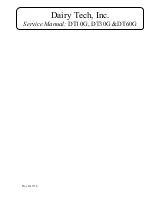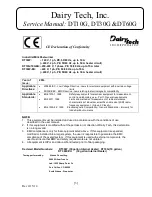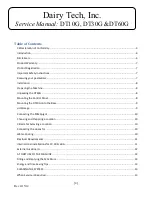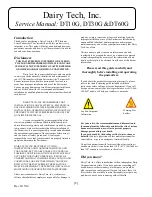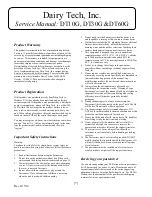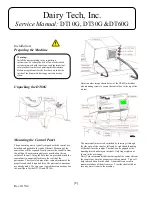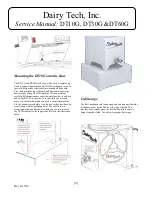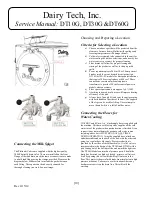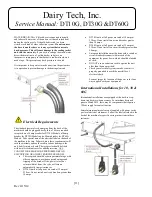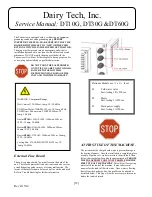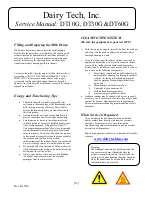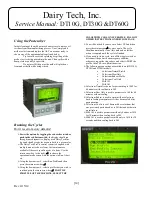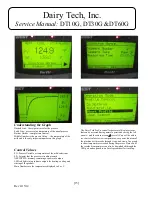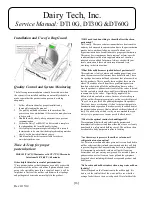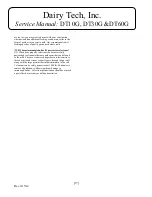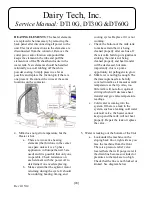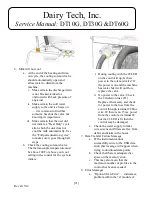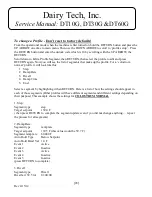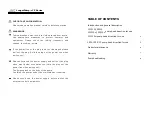
[16]
Rev 4/15/14
Dairy Tech, Inc.
Service Manual:
DT10G, DT30G &DT60G
Installation and Use of a Bag Guard
Quality Control and System Monitoring
The following recommendations should be carried out when
the system is first installed and then on a monthly schedule to
make certain that the pasteurization process is working
adequately.
1.
Follow all instructions for proper installation by
thoroughly reading the manual.
2.
Use quality milk and colostrum in the machine. The
process can be overwhelmed if there are too many bacteria
to begin with.
3.
Handle the milk cleanly after pasteurization to prevent
recontamination.
4.
Utilize the Dairy Tech Milk Test Kit to send a sample to
the independent lab for milk quality testing.
5.
Verify display temperatures periodically with a second
thermometer to be sure that the displayed reading matches
closely with a trusted calibrated source.
6.
Additional milk test kits are available for order at
www.dairytechinc.com
Time & Temp for proper
pasteurization:
Milk 145°F(63°C)/30 minutes or 161°F(72°C)/30 seconds
Colostrum 140°F (60°C)/ 60 minutes
Other helpful hints for successful pasteurization:
*Time pasteurization so that it happens as quickly as possible
after harvest of the milk or colostrum. If pasteurization is not
going to be started for more than a couple of hours, it will be
important to first cool the milk or colostrum so that spoilage
and pathogenic bacteria do not multiply in the product.
*Will I need to add anything to the milk after it has been
pasteurized?
Not Usually. There are certain vitamins that are heat sensitive
and may be decreased in concentration due to the pasteurization
process but to our knowledge, no cases of deficiency or
hypovitaminosis have been attributed to proper pasteurization.
There may be circumstances due to regional or farm-specific
conditions that would dictate supplementation of vitamins,
minerals or even added fat/protein. Always check with your
local veterinarian if there are such suspicions and treat
according to their instructions.
*What if the milk becomes spoiled before I pasteurize it?
This condition is fairly common and can happen at times even
when the same successful routines have been followed. There
are spoilage bacteria in milk and colostrum that release acid as
their by-products. This is usually lactic acid but there are also
others. The release of acid from these proliferating bacteria
then drives down the pH of the milk making it more acidic.
Once the product is pasteurized it is safe for the calves to drink,
but this can lead to rancid odors and flavors that might decrease
consumption by the calves. Digestibility might also be
different which can lead to scours. In cases of severe drop in
pH, the milk will separate completely with a very thick layer of
“cheese” on top or thick like pudding throughout the product.
This is not due to overheating, it is due to the fact that protein
denaturation and separation is made worse by the added heat of
the pasteurization process. Heat combined with spoiled milk of
low pH is a bad recipe which is why we recommend that you
always try to pasteurize as soon as possible after harvest.
* What is the optimal routine for handling milk?
We recommend that milk and colostrum be pasteurized
immediately after harvest and then either fed at once or cleanly
transferred to a refrigerated holding vessel. The milk can then
be reheated to body temperature prior to feeding.
*Are there ways to preserve the milk or colostrum if
refrigeration is not an option?
Yes. Potassium sorbate and other preservatives can be added to
milk or colostrum that is already pasteurized and this will help
to prevent the growth of any remaining bacteria in the product.
It is important to note that K-sorbate will not kill existing
bacteria but will prevent any new growth. Do not add it prior to
pasteurization as it will cause a lower pH and the symptoms
described above including thickened or separated product and
bad flavors.
*Do I need to add milk extenders when using waste milk on
the dairy?
This will depend on the fluctuations in the milk supply. It is
best to test the total solids of the waste milk to see what the
average looks like over a one week period. If total milk solids
Содержание Platinum Series
Страница 2: ...2 Rev 4 15 14 Dairy Tech Inc Service Manual DT10G DT30G DT60G...
Страница 31: ...31 Rev 4 15 14 Schematic for Model DT10 30 60G 200 to 240VAC 1P 50 60Hz USA Domestic...
Страница 32: ...32 Rev 4 15 14 Schematic for Model DT10 30 60G 200 to 240VAC 1P 50 60Hz England Japan...
Страница 33: ...33 Rev 4 15 14 Schematic for Model DT10 30 60G 400VAC 3P Europe...
Страница 34: ...34 Rev 4 15 14 NOTES...
Страница 38: ...38 Rev 4 15 14...

